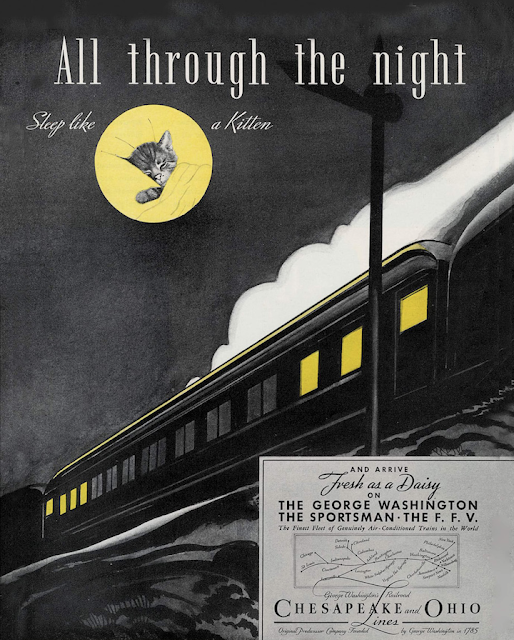I’ve always thought the Chessie logo was a cat but I never knew why they used a cat image, and a very flawed cat image (I thought) until recently.
Chessie System was a holding company that owned the Chesapeake & Ohio Railway (C&O), the Baltimore & Ohio Railroad (they wanted to retain the B&O’s tax-exempt status in the state of Maryland), the Western Maryland Railway (WM) and several smaller carriers. After a long struggle with the New York Central Railroad (NYC), the Chesapeake & Ohio won control of the Baltimore & Ohio when the Interstate Commerce Commission (ICC) approved the merger on December 31, 1962. This was the start of what later became the Chessie System.
“Chessie System” was not a new name for the C&O. During the Great Depression the railroad’s management sought ways to boost the railroad’s declining passenger business. The C&O’s public relations officer in the 1930s saw a newspaper advertisement that featured “a cuddly sleeping kitten" as a symbol to promote the C&O’s new air-conditioned sleeping cars and to revive the declining passenger count. He purchased the artist’s sleeping kitten artwork for $5; then developed the slogan “Sleep Like a Kitten and Wake Up Fresh as a Daisy in Air-Conditioned Comfort.”
The kitten was named Chessie (after the railroad); the first advertisement appeared in the September 1933 issue of Fortune magazine. The new logo was an immediate hit; it propelled ticket sales as well as merchandising for the railroad.
Many consider “Chessie” as “the greatest marketing idea ever conceived by a railroad.” For those old enough it is remembered in advertisements with a simplified slogan, “Sleep Like A Kitten.”
After passenger rail travel declined in the years following World War II, the Chessie the kitten logo was discontinued; by the late 1960s it had been forgotten by most of the public.
Some 40 years after Chessie was first used in the railroad’s advertising, Watikins charged Howard Skidmore, a successor to Lionel Probert, to lead the effort to design a new corporate logo and paint scheme. Skidmore assigned the task to Franklyn Carr, who led the company’s creative team.
Several factors went into Carr’s work, the Chessie System had to have a bright paint scheme to attract attention for “safety reasons,” while “bold lettering would show strength and also catch the eye.”
Using the “C&O’s famous kitten as a template,” Carr “overlaid the design within a large letter ‘C’ as a silhouette.”
Fun Fact #1: The railroad paid artist Guido Gruenewald, name spelled in a variety of ways, a mere $5 for use of his work entitled, “The Sleeping Cat,” a price comparable to $100 today. Gruenewald or Grünewald, a Viennese artist, specialized in drawing cats and other animals, accepted the offer. His original drawing was sold to the Robertson-Deschamps Gallery in New York. Gruenewald, unfortunately, died around the time his drawing was becoming famous, never seeing the tremendous love a nation would develop for his drawing.
Fun fact #2: C&O received thousands of letters from every state and from overseas with questions about Chessie and requests for calendars. Within one month after the 1935 kitten made her appearance, more than 20,000 letters were received requesting a calendar. At one point, the letters came to C&O at a rate of more than 1,000 per day.
Fun fact #3: Chessie merchandise appeared from various manufacturers including Sears, Roebuck and Company produced a line of Chessie blankets, bedspreads, and matching curtains for children’s rooms in the 1960’s.
Fun Fact #4: The extremely popular Chessie calendar is still published annually today by C&O Historical Society. It is produced to carry on the tradition of the railway and is the longest continuously running railroad calendar (and oldest) in America. Clements says the historical society still makes and sells Chessie memorabilia due to good public response.







No comments:
Post a Comment